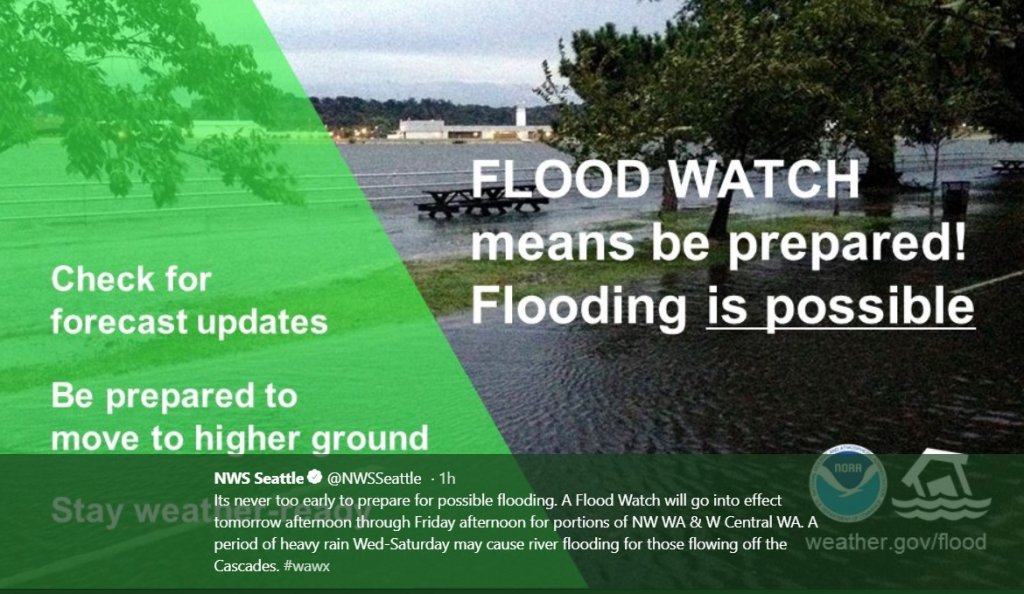Landslides, floods and falling iguanas: a series of dangerous storms covered the USA
In late January and early February, storms over the Pacific Ocean will continue to travel across the northwestern United States, giving the impression that Mother Nature launched a long freight train with rainfall over America. AccuWeather.

Фото: Depositphotos
During the winter period, storm currents may be commonplace for permanent residents of the Northwest, but many are already tired of the ruthless storm regime, which will last until the end of January, and possibly longer. Meteorologists say that the sun's rays will be in short supply.
As storms travel over the northern Pacific Ocean and extend northwest, they can hit this region on average every one to two days.
As the snow level drops only a few thousand meters relative to sea level, storms will bring heavy rains at low altitudes. Each storm can bring in a few tenths of an inch to a couple of inches (5 cm) of rain.
As the succession of storms progresses, individual cases of flooding in cities, landslides and landslides during rain are expected. Over an approximately 2-week period, it is likely that in some regions 6-12 inches (15-30 cm) of rain will be expected in the form of rain with a locally higher amount of rainfall in the lowlands, on the west-facing slopes of the Olympic Mountains and the Cascade Mountains of Washington and Oregon.
Motorists should be careful when driving on minor mountain roads, as debris can be washed to the surface of the road, and in some extreme cases the road itself may be blurred.
The problem could be snow levels that rise above average relative to sea level. The series of storms will see higher snow levels, with precipitation occurring at elevations between 4000 and 6000 feet, AccuWeather senior meteorologist Dave Samuel said.
On the subject: 20 useful things that every winter should be in every car
“The rain will cause significant snow melt at intermediate elevations and increase downdraft flow, significantly increasing the risk of creek formation and river flooding,” Samuel said.
At the passes, it will periodically snow or a mixture of snow and rain. Driving through the pass, motorists must comply with traffic safety rules. Even in mild weather, fog and gusty wind in these areas can be a problem.
In cities such as Spokane, Washington, as well as Dulles and Medford, Oregon, unlike mid-January, there will be virtually no snow.

Photo: twitter.com/NWSSeattle
Over the Cascade Mountains of Washington and the Olympic Mountains, each coastal storm will bring a total of 6-12 inches (15-30 cm) of snow, in some places it may be more. Snow will also accumulate over the Oregon Cascade Mountains, and every third storm, on average, has every chance of bringing snow to northern Sierra Nevada in California.
Excessive snow, intermittent gusty winds and variable air temperature will increase the risk of avalanches, which becomes higher with each storm. Deviation from the marked and verified route can be life threatening.
According to weather forecasters, these storms may not become extremely strong, but their constant flow can lead to coastal erosion and periodic coastal floods.
Frequent storms can also lead to flight delays, especially at Seattle-Tacoma International Airport. Motorists will need to consider the extra braking distance during heavy rain.
635 AM Radar Update | Rain is sliding north this morning across the area. Rain for much of today through Thursday. Give yourself extra time if you're heading out this morning! #WAwx pic.twitter.com/LCSv7O5jgH
- NWS Seattle (@NWSSeattle) January 22, 2020
Residents of Florida and Georgia warned of falling iguanas
Since the coldest air of the season spreads over the eastern part of the USA, the temperature drops even in the southernmost states: from Louisiana to North and South Carolina and Florida, the air warms up on average by 10-15 degrees less than normal. January 22, there are warnings of hypothermia and freezing in Florida and Georgia, writes CNN.
On the afternoon of January 21, the National Weather Service in Miami issued a rare forecast for relatively low temperatures, but it concerned the iguanas. Yes, you read that.
On the subject: Iguanas freeze in Miami: dangerous colds await Americans after record snowfalls
"Don't be surprised to see iguanas falling from trees tonight," the weather service tweeted.

Photo: twitter.com/NWSMiami
Iguanas often sleep in trees when their bodies are in a state of stupor due to cold temperatures. That's why they fall on streets, cars, swimming pools and even on people walking around - it seems as if an iguana fell from the sky. And because iguanas are quite large (adult males can reach 5 feet in length and weigh up to 20 pounds), falling can be dangerous to humans.
Iguanas do not tolerate cold well—once temperatures drop below 50 degrees Fahrenheit (10 Celsius), iguanas begin to become lethargic and enter a state of stupor. They appear dead, but they are not. Iguanas continue to breathe, although their body functions are in critical condition. This is a way of protecting their body.
If temperatures persist in the region of 40 degrees (4,4 C) for eight or more hours, many iguanas will die, especially small ones.
“The temperature threshold at which iguanas begin to enter a dormant state largely depends on the size of the iguana,” explains Ron Magill, director of communications for Zoo Miami. “The larger the iguana, the longer it can tolerate cold temperatures.”
On the subject: How to avoid hypothermia in the winter: useful tips
Many iguanas in South Florida have adapted to penetrate burrows, where they remain isolated from the cold. They usually also live near large bodies of water, which are usually warmer than air temperature, which helps them survive short-term cooling.
However, not everyone is concerned about the well-being of iguanas. They are considered invasive species, so some people are eagerly awaiting the opportunity to rid their yards of these reptiles.
“I know there are several iguana hunters who are looking forward to the coming cold front because it will make it easier for them to remove invasive reptiles from the South Florida environment—the iguanas won't be able to escape,” Magill said.
Read also on ForumDaily:
Flights, hotels, cruises: how to travel and relax in the low season
In a small town in Alaska, an early census began: what is the reason for the rush
For 70 years, the oceans warmed up to an explosion temperature of 3 billion atomic bombs
Subscribe to ForumDaily on Google NewsDo you want more important and interesting news about life in the USA and immigration to America? — support us donate! Also subscribe to our page Facebook. Select the “Priority in display” option and read us first. Also, don't forget to subscribe to our РєР ° РЅР ° Р »РІ Telegram and Instagram- there is a lot of interesting things there. And join thousands of readers ForumDaily New York — there you will find a lot of interesting and positive information about life in the metropolis.











